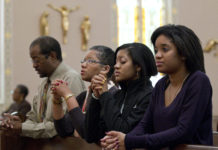
The call to a change of heart and a change of life was a hallmark of the ministry of Jesus, of His forerunner, John the Baptist, and of His apostles. And the Lenten season, which has been part of the Christian year from the earliest days of the Church, has always made repentance its centerpiece.
But if we take a good look at the way the early Church approached sin, repentance and the Lenten season, we notice some significant differences from the way American Catholics of the 21st century ordinarily approach these things.
Many today see Lent as a season of spiritual self-help. Each person picks something to give up and tries to work on a fault or two. We may attend a parish penance service, but Lenten penance is pretty much a personal thing.
For the first few centuries after the resurrection, to become a Christian was a radical act. It involved a complete break with a former way of life and the values of a pagan society. Baptism was not only a solemn commitment to a holy God and a holy lifestyle, but an empowerment by the Holy Spirit that made it possible to live the Gospel.

So for a person to fall into serious sin after baptism was abnormal. It signaled something was seriously wrong and required an urgent response not only on the part of sinner, but of the entire community.
Today, a lengthy period of sometimes painful physical therapy is often required to restore an injured limb to health. In the early Church, a lengthy period of penance was understood as spiritual rehab, necessary to restore the health of sinners and the well-being and equilibrium of the Church.
For the first 800 years of the Church, those who had fallen into grave sin would come to church for a prolonged period dressed in sackcloth and ashes, seeking the prayers of the community. Though sins were confessed privately to the bishop, penance was therefore a public affair.
Lent was a special time when the whole Church labored in penance alongside catechumens preparing for baptism and penitents preparing to receive absolution and reconciliation at Easter.
It was a time of solidarity and unity, with the mature and the strong walking shoulder to shoulder with the immature and the weak, all wearing the same ashes.
While praying and doing penance for those seeking healing from serious sin, everyone sought purification from the sneaky venial sins that quietly eat away at our hearts and lurk in so many nooks and crannies of our lives.
This solidarity and unity in doing penance together underscores another feature of repentance in the early Church. The Church is holy according to the creed. But it is also one.
The early Church took seriously the call to unity, expressed in a love between Christians that was striking to those from the outside looking in. The first church collections were for widows and the poor, not for the maintenance of buildings. Martyrs would embrace one another in the arena before their execution and cause the spectators to remark, “See how they love one another.”
But like us, Christians of the first centuries sometimes lost their perspective. Sins against unity were considered among the most serious of spiritual offenses.
When young members of the Church of Corinth tore the community in two, seizing leadership from the elders appointed by the apostles, Pope Clement of Rome intervened. He did not issue a bureaucratic decree to resolve the problem, but rather a long and beautiful teaching on the root of disunity and the nature of true repentance.
What is the cause of disunity and dissension, he asked. Is it not pride? Rivalry, bitter criticism of others, the dwelling on others’ faults, refusal to forgive shortcomings — don’t these come from a perverse passion to exalt and justify ourselves?
Ultimately the pride that disrupts unity among people is the very thing that drives a wedge between us and God. For pride exalts itself against everyone, even God.
In the tradition of the Fathers of the Church, picked up and developed by the medieval monks, seven deadly sins are identified from which all other sins flow. The deadliest of these seven is pride.
Therefore, according to the early Fathers of the Church, all true repentance must begin with humility. To take our eyes off others’ sins and instead to admit our own — this is only possible through humility. To take our eyes off ourselves and look to God is also an act of humility.
“Humility” is closely related to the word “humus,” the component of earth that makes it fertile. When we get too big for our britches and our life becomes spiritual sterile, we need to recall that we came from the earth and will return to the earth. We need to get grounded once again.
Perhaps this is why the season of Lent begins with the sign of the cross traced on our forehead with ashes. “Remember, man, that you are dust and unto dust you shall return.”




![[VIDEO] Make Sunday feel like Sunday again](https://www.catholicsun.org/wp-content/uploads/2021/04/2021-YOUTUBE-BISHOP-MESSAGE-THUMBNAIL-ENGLISH-218x150.png)

